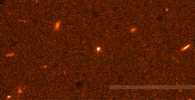Gamma-Ray Bursts
A team of astronomers, led by Kailash Sahu of the Space Telescope Science Institute (STScI) in Baltimore, MD, is reporting this conclusion at the 190th Meeting of the American Astronomical Society in Winston-Salem, NC. They used the Hubble Space Telescope to study the fading optical counterpart to a burst that happened on February 28, 1997.
Nature's most powerful explosions, gamma-ray bursts, occur among the normal stellar population inside galaxies scattered across the universe. This means that, on average, a gamma-ray burst goes off once every few million years inside our Milky Way galaxy and may explode within a few thousand light-years from Earth every few hundred million years. The energy released in such a titanic explosion, which can last from a fraction of a second to a few hundred seconds, is equal to all of the Sun's energy generated over its 10 billion year lifetime.
"Hubble's unmatched resolution was crucial in pinpointing the fact that the gamma-ray burst is away from the center," Sahu says. "This would rule out massive black holes, thought to dwell in the cores of most galaxies, as the source of these incredible explosions."
Keck telescope spectroscopic measurements of the optical counterpart to another gamma-ray burst, which exploded on May 8, found that its distance from Earth is several billion light-years. The Keck observation establishes that gamma-ray bursts are truly extragalactic in location and origin.
However, a June 2nd Hubble observation of this newer burst source, made with both of the newly installed science instruments, failed to reveal a galaxy adjacent to the optical counterpart.
One possible mechanism for unleashing such a titanic fireball of energy is the collision of a neutron star with another neutron star or a black hole. The Hubble observations support this model because it appears gamma-ray bursts occur in the disk of a galaxy, where there is ongoing stellar formation, and so there should be an abundance of neutron stars from recently exploded supernovae.
Read the page GAMMA-RAY BURSTS at the Scientific American web site, by Gerald J. Fishman and Dieter H. Hartmann (Scientific American, July 1997).
Hubble Tracks the Fading Optical Counterpart of a Gamma-Ray Burst
Full Press Release:
Hubble Pinpoints Optical Counterpart of Gamma-Ray Burst in a Distant Galaxy
Full Press Release:
Mysterious Fireball from a Cataclysmic Explossion

|
The image shows the visible fireball from a gamma-ray burst occurred on May 8. Hubble observations to acquire the fading fireball were made on June 2. No accompanying object, such as a host galaxy, can be found near the burst. This result adds to the puzzlement over of the source of these enigmatic explosions, because a previous Hubble image of another gamma-ray burst counterpart identified a potential host galaxy. If a galaxy is present, and at the distance suggested by Keck spectroscopy, it is much fainter than our Milky Way. |
Full Press Release: